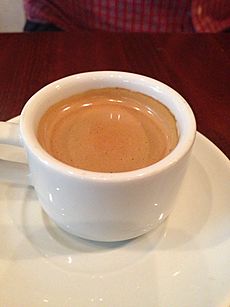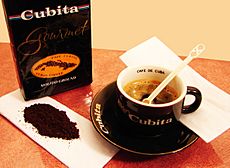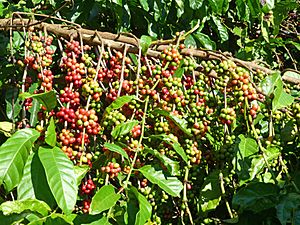Coffee production in Cuba facts for kids

Coffee has been grown in Cuba for a long time, since the mid-1700s. French farmers, who left Haiti during their revolution, helped Cuba grow more coffee. Coffee farming grew a lot in eastern Cuba in the 1800s and early 1900s. At its best, Cuba exported over 20,000 metric tons of coffee beans each year in the mid-1950s. After the Cuban Revolution, coffee production slowly went down. It reached very low levels during tough economic times. Once a big export for Cuba, coffee is now a small part of its trade. By the 2000s, 92 percent of the country's coffee was grown in the Sierra Maestra mountains. All Cuban coffee is exported by Cubaexport. This company pays set prices to the coffee growers.
Contents
A Look Back: Coffee's Journey in Cuba
How Coffee Came to Cuba
The first coffee plant arrived in Cuba in 1748. It was brought by José Antonio Gelabert. Later, in 1791, French people came to Cuba. They were leaving the Haitian Revolution, where slavery was ending. These French farmers brought better ways to grow coffee.
Coffee Farms Become World Heritage Sites
Coffee farming in eastern Cuba in the 1800s and early 1900s created a special cultural landscape. This shows an important time in how farming developed. Because of this, UNESCO listed the "Archaeological Landscape of the First Coffee Plantations in the South-East of Cuba" as a World Heritage Site in 2000.
Coffee Exports During World War I
When World War I started in 1914, it became hard to send Cuban goods, including coffee, to Europe. This was especially true after Germany began using submarines to sink ships in 1915.
Cuba's Coffee Boom Before the Revolution
Before the time of Fidel Castro, Cuba's coffee industry was very successful. In the mid-1950s, Cuba was exporting over 20,000 metric tons of coffee beans every year. Cuban coffee was sold at high prices around the world. Much of it went to Europe, especially the Netherlands and Germany.
Changes After the Cuban Revolution
After the Cuban Revolution in 1959, coffee production in Cuba went down. This happened because large farms were broken up. Also, small farmers had less reason to grow coffee. Because of this, Cuban coffee producers started mixing coffee beans with roasted peas. This mix was common in Cuba until 2005, when pure coffee returned. However, in 2011, peas were added back to Cuban coffee because the price of Robusta coffee went up.
The US Embargo's Impact
In 1962, the United States stopped importing all goods from Cuba. This was called an embargo. It further hurt the Cuban coffee industry. During this time, Cuban coffee was not sold in the US market.
Coffee Production Rebounds After Tough Times
The end of the Soviet Union in the early 1990s caused a big drop in Cuban coffee production. It went from 440,000 bags in 1989-1990 to a very low 7,000 bags in 2007-2008. But since then, Cuban coffee production has improved. It now produces between 100,000 and 130,000 bags each year. This is thanks to government help, like raising coffee prices and providing better equipment.
How Cuban Coffee is Produced
Where Coffee Grows in Cuba
By the 2000s, 92 percent of Cuba's coffee was grown in the Sierra Maestra mountains. It often grows under the shade of forest trees. The coffee harvest happens from September to January, with the busiest time in October and November.
Types of Coffee Beans Grown
Cuba grows two main types of coffee beans: arabica and robusta. Most of this coffee comes from small family farms. In 2003, Cuba started exporting organic coffee to Europe and Japan. Over 4,000 hectares of land were certified as organic. This area produced 93 metric tons of organic coffee. This organic coffee sold for 40% more than regular Cuban coffee.
Changes in Coffee Farmland
According to the FAO, the total amount of land used for coffee farming in Cuba has decreased. It went from 170,000 hectares in 1961 to 28,000 hectares in 2013.
Exporting Cuban Coffee
All coffee from Cuba is exported by a company called Cubaexport. This company pays a set price to coffee growers and processors. Today, Japan and France are the main countries that buy Cuban coffee. Smaller amounts go to Germany, the United Kingdom, Canada, and New Zealand.
Coffee for Cubans at Home
Coffee for people living in Cuba is limited. Citizens receive about two ounces of coffee every 15 days as part of their food rations.
See also
 In Spanish: Producción de café en Cuba para niños
In Spanish: Producción de café en Cuba para niños



